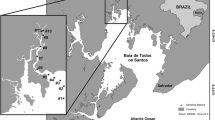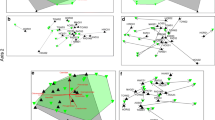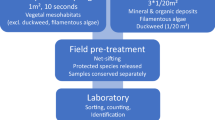Abstract
As part of an effort to estimate estuarine habitat values with respect to ecological indicators of benthic macrofaunal community condition, an optimal (effective and least costly) sampling protocol (sample unit size [area x depth], sieve mesh size, and sample number [n]) was determined. The goal was to use four ecological indicators (number of species, abundance, biomass, and fish and crab prey abundance) to detect differences among four intertidal habitats in Willapa Bay, Washington, United States. The four habitats were eelgrass (Zostera marina), Atlantic cordgrass (Spartina alterniflora), mud shrimp (Upogebia pugettensis), and ghost shrimp (Neotrypaea californiensis). Four sample unit areas (0.005, 0.010, 0.015, and 0.020 m2), two sample unit depths (0–5 and 0–10 cm), and two sieve mesh sizes (1.0 and 0.5 mm) were evaluated. The optimal sampling protocol was defined as the least costly protocol capable of reliably (statistical power, 1−β≥0.80) detecting significant (α=0.05) differences among ≥4 of the 6 pairwise habitat contrasts by ANOVA on all four ecological indicators. The relative cost of each sampling protocol was estimated as a direct function of the sample unit size and number and the cost-in-processing-time ratios of 1 (5 cm deep):1.7 (10 cm deep) and 1 (≥1.0 mm macrofauna size fraction); 2.5 (≥0.5 mm macrofauna size fraction), which were taken from previous studies. The optimal sampling protocol was 15–20, 0.01-m2×5-cm deep, 0.5-mm mesh samples per habitat.
Similar content being viewed by others
Literature Cited
Albright, R. and P. K. Bouthillette. 1982. Benthic invertebrate studies in Grays Harbor, Washington, U.S. Army Corps of Engineers, Contract No. DACW67-80-C-0091. Seattle, Washingon.
Allee, R. J., M. Dethier, D. Brown, L. Deegan, R. G. Ford, T. F. Hourigan, J. Maragos, C. Schoch, K. Sealey, R. Twilley, M. P. Weinstein, and M. Yoklavich. 2000. Marine and estuarine ecosystem and habitat classification. NOAA-Fisheries, National Oceanic and Atmospheric Administration Technical Memorandum NMFS-F/SPO-43. Silver Spring, Maryland.
Andrew, N. L. andB. D. Mapstone. 1987. Sampling and the description of spatial pattern in marine ecology.Oceanography and Marine Biology. An Annual Review 25:39–90.
Bachelet, G. 1990. The choice of a sieving mesh size in the quantitative assessment of marine macrobenthos: A necessary compromise between aims and constraints.Marine Environmental Research 30:21–35.
Bayer, R. D. 1981. Shallow-water intertidal ichthyofauna of the Yaquina estuary, Oregon.Northwest Science 55:182–193.
Blundon, J. A. andV. S. Kennedy. 1982. Refuges for infaunal bivalves from blue crab,Callinectes sapidus (Rathbun), predation in Chesapeake Bay.Journal of Experimental Marine Biology and Ecology 65:67–81.
Boesch, D. F. 1977. Application of numerical classification in ecological investigations of water pollution. U.S. Environmental Protection Agency, Ecological Research Series, EPA-600/3-77-033. Washington, D.C.
Boström, C. B. andE. Bonsdorff. 1997. Community structure and spatial variation of benthic invertebrates associated withZostera marina (L.) beds in the northern Baltic Sea.Journal of Sea Research 37:153–166.
Bottom, D. L. andK. K. Jones. 1990. Species composition, distribution, and invertebrate prey of fish assemblages in the Columbia River estuary.Progress in Oceanography 25:243–270.
Bowden, D. A., A. A. Rowden, andM. J. Attrill. 2001. Effect of patch size and in-patch location on the infaunal macroinvertebrate assemblages ofZostera marina seagrass beds.Journal of Experimental Marine Biology and Ecology 259:133–154.
Buchanan, J. B. 1984. Sediment analysis, p. 41–65.In N. A. Holme and A. D. McIntyre (eds.), Methods for the Study of Marine Benthos, IBP Handbook No. 16, 2nd edition. Blackwell Scientific Publications, Oxford, U.K.
Castillo, G. C., T. W. Miller, J. W. Chapman, and H. W. Li. 1996. Non-indigenous species cause major shifts in the foodbase of estuarine-dependent fishes, p. 101–109.In D. Mackinlay and K. Shearer (eds.), Gutshop '96. Feeding Ecology and Nutrition in Fish. Symposium Proceedings. International Congress on the Biology of Fish. San Francisco, California.
Cochran, W. G. 1977. Sampling Techniques, 3rd edition. John Wiley and Sons, New York.
Cohen, J. 1988. Statistical Power Analysis for the Behavioral Science, revised edition. Academic Press, Orlando, Florida.
DeBen, W. A., W. D. Clothier, G. R. Ditsworth, andD. J. Baumgartner. 1990. Spatio-temporal fluctuations in the distribution and abundance of demersal fish and epibenthic crustaceans in Yaquina Bay, Oregon.Estuaries 13:469–478.
Diaz-Ramos, S., D. L. Stevens, Jr., and A. R. Olsen. 1996. Environmental Monitoring and Assessment Program. U.S. Environmental Protection Agency EMAP Statistical Methods Manual EPA/620/R-96/002. Corvallis, Oregon.
Downing, J. A. 1979. Aggregation, transformation, and the design of benthos sampling programs.Journal of the Fisheries Research Board of Canada 36:1454–1463.
Dumbauld, B. R., K. M. Brooks, andM. H. Posey. 2001. Response of an estuarine benthic community to application of the pesticide carbaryl and cultivation of Pacific oysters (Crassostrea gigas) in Willapa Bay, Washington.Marine Pollution Bulletin 42:826–844.
Eleftheriou, A. andN. A. Holme. 1984. Macrofaunal techniques, p. 140–216.In N. A. Holme and A. D. McIntyre (eds.), Methods for the Study of Marine Benthos, IBP Handbook No. 16, 2nd edition. Blackwell Scientific Publications, Oxford, U.K.
Elliott, J. M. 1983. Some Methods for the Statistical Analyses of Samples of Benthic Invertebrates, 2nd edition. 3rd impression. Freshwater Biological Association Scientific Publication No. 25, The Ferry House, U.K.
Emmett, R. L., S. L. Stone, S. A. Hinton, andM. E. Monaco. 1991. Distribution and abundance of fishes and invertebrates in west coast estuaries, Volume II. Species Life history summaries. Strategic Environmental Assessments Division. ELMR Report No. 8. National Oceanic and Atmopsheric Administration, National Ocean Service. Rockville, Maryland.
Ferraro, S. P., F. A. Cole, W. A. DeBen, andR. C. Swartz. 1989. Power-cost efficiency of eight macrobenthic sampling schemes in Puget Sound, Washington, USA.Canadian Journal of Fisheries and Aquatic Sciences 46:2157–2165.
Ferraro, S. P., R. C. Swartz, F. A. Cole, andW. A. DeBen. 1994. Optimum macrobenthic sampling protocol for detecting pollution impacts in the Southern California Bight.Environmental Monitoring and Assessment 29:127–153.
Furota, T. and R. L. Emmett. 1993. Seasonal changes in the intertidal and subtidal macrobenthic invertebrate community structure in Baker Bay, lower Columbia River estuary. U.S. Department of Commerce, National Oceanic and Atmospheric Administration Technical Memorandum NMFS-NWFSC-5. Springfield, Virginia.
Gotshall, D. W. 1977. Stomach contents of Northern California Dungeness crabs,Cancer magister.California Fish and Game 63:43–51.
Gray, J. S. 1981. The Ecology of Marine Sediments. Cambridge University Press, Cambridge, U.K.
Green, R. H. 1979. Sampling Design and Statistical Methods for Environmental Biologists. John Wiley and Sons, New York.
Gunderson, D. R., D. A. Armstrong, Y.-B. Shi, andR. A. McConnaughey. 1990. Patterns of estuarine use by juvenile English sole (Parophrys vetulus) and Dungeness crab (Cancer magister).Estuaries 13:59–71.
Hall, S. J. 1994. Physical disturbance and marine benthic communities: Life in unconsolidated sediments.Oceanography and Marine Biology: An Annual Review 32:179–239.
Hayes, J. P. andR. J. Steidl. 1997. Statistical power analysis and amphibian population trends.Conservation Biology 11:273–275.
Hedgpeth, J. W. and S. Obrebski. 1981. Willapa Bay: A historical perspective and a rationale for research. U.S. Fish and Wildlife Service FWS/OBS-81/03. Washington, D.C.
Heltshe, J. F. andT. A. Ritchey. 1984. Spatial pattern detection using quadrat samples.Biometrics 40:877–885.
Hines, A. H. andK. L. Comtois. 1985. Vertical distribution of infauna in sediments of a subestuary of central Chesapeake Bay.Estuaries 8:296–304.
Holland, A. F., N. K. Mountford, M. H. Hiegel, K. R. Kaumeyer, andJ. A. Mihursky. 1980. Influence of predation on infaunal abundance in upper Chesapeake Bay, USA.Marine Biology 57:221–235.
Holme, N. A. 1964. Methods of sampling the benthos.Advances in Marine Biology 2:171–260.
Hunsaker, C. T. and D. E. Carpenter. 1990. Ecological indicators for the Environmental Monitoring and Assessment Program. U.S. Environmental Protection Agency EPA 600/3-90/060. Research Triangle Park, North Carolina.
Jones, C. G., J. H. Lawton, andM. Shachak. 1994. Organisms as ecosystem engineers.Oikos 69:373–386.
McIntyre, A. D., J. M. Elliott, andD. V. Ellis. 1984. Introduction: Design of sampling programmes, p. 1–26.In N. A. Holme and A. D. McIntyre (eds.), Methods for the Study of Marine Benthos. IBP Handbook No. 16, 2nd edition. Blackwell Scientific Publications, Oxford, U.K.
O'Brien, R. G. 1998. A tour of UnifyPow: A SAS module/macro for sample size analysis, p. 1346–1355. In Proceedings of the 23rd SAS Users Group International Conference. SAS Institute, Cary, North Carolina.
Orth, R. J. 1973. Benthic infauna of eelgrass,Zostera marina beds.Chesapeake Science 14:258–269.
Pearson, T. H. andR. Rosenberg. 1978. Macrobenthic succession in relation to organic enrichment and pollution of the marine environment.Oceanography and Marine Biology: An Annual Review 16:229–311.
Peterman, R. M. 1990. Statistical power analysis can improve fisheries research and management.Canadian Journal of Fisheries and Aquatic Scineces 47:2–15.
Plumb, R. H. 1981. Procedures for handling and chemical analyses of sediment and water samples. U.S. Army Engineers Waterways Experiment Station Technical Report EPACE-81-1. Vicksburg, Mississippi.
Posey, M. H. 1986. Changes in a benthic community associated with dense beds of a burrowing deposit feeder,Callianassa californiensis.Marine Ecology Progress Series 31:15–22.
Posey, M. H., B. R. Dumbauld, andD. A. Armstrong. 1991. Effects of a burrowing mud shrimp,Upogebia pugettensis (Dana), on abundances of macro-infauna.Journal of Experimental Marine Biology and Ecology 148:283–294.
Puget Sound Estuary Program. 1997. Recommended protocols for sampling and analyzing subtidal benthic macroinvertebrate assemblages in Puget Sound. Recommended Protocols for Measuring Selected Environmental Variables in Puget Sound. Puget Sound Water Quality Authority, Olympia, Washington.
Rader, D. N. 1984. Salt-marsh benthic invertebrates: Small-scale paterns of distribution and abundance,Estuaries 7:413–420.
Rees, H. L. 1984. A note on mesh selection and sampling efficiency in benthic studies.Marine Pollution Bulletin 15:225–229.
Reise, K. 1985. Tidal Flat Ecology. Springer-Verlag, Heidelberg, Germany.
SAS Institute Inc. 1985. SAS User's Guide: Basics, Version 5 edition. SAS Institute Inc., Cary, North Carolina.
Service, S. K. andR. J. Feller. 1992. Long-term trends of subtidal macrobenthos in North Inlet, South Carolina.Hydrobiologia 231:13–40.
Simenstad, C. A., C. D. Tanner, and R. M. Thom. 1990. Estuarine wetland restoration monitoring protocol: Appendices. U.S. Environmental Protection Agency FRI-UW-89. Seattle, Washington.
Simenstad, C. A., C. D. Tanner, R. M. Thom, and L. L. Conquest. 1991. Estuarine habitat assessment protocol. U.S. Environmental Protection Agency EPA 910/9-91-037. Seattle, Washington.
Simpson, G. G., A. Roe, andR. C. Lewontin. 1960. Quantitative Zoology, revised edition. Harcourt, Brace and World, New York.
Sokal, R. R. andF. J. Rohlf. 1995. Biometry. The Principles and Practice of Statistics in Biological Research, 3rd edition. W. H. Freeman and Company, New York.
Stevens, Jr.,D. L. 1997. Variable density grid-based sampling designs for continuous spatial populations.Environmetrics 8: 167–195.
Stickney, R. R., G. L. Taylor, andD. B. White. 1975. Food habits of five species of young southeastern United States estuarine Sciaenidae.Chesapeake Science 16:104–114.
Swartz, R. C. 1978. Techniques for sampling and analyzing the marine macrobenthos. U.S. Environmental Protection Agency EPA-600/3-78-030. Corvallis, Oregon.
Toft, C. A. andP. J. Shea. 1983. Detecting community-wide patterns: Estimating power strengthens statistical inference.American Naturalist 122:618–625.
U.S. Environmental Protection Agency (USEPA). 1991. Monitoring Guidance for the National Estuary Program, Interim Final. U.S. Environmental Protection Agency EPA 503/8-91-002. Washington, D.C.
U.S. Environmental Protection Agency (USEPA). 1998. Guidelines for Ecological Risk Assessment, Risk Assessment Forum. U.S. Environmental Protection Agency, EPA/630/R-95/002F. Washington, D.C.
Warwick, R. M. andK. R. Clarke. 1991. A comparison of some methods for analysing changes in benthic community structure.Journal of the Marine Biological Association U.K. 71:225–244.
Williams, S. L. and J. B. Zedler. 1992. Restoring sustainable coastal ecosystems on the Pacific Coast. Establishing a research agenda. California Sea Grant College, University of California, Report No. T-CSGCP-026. La Jolla, California.
Zipperer, V. T. 1996. Ecological effects of the introduced cordgrass,Spartina alterniflora, on the benthic community structure of Willapa Bay, Washington, M.S. Thesis, University of Washington, Seattle, Washington.
Author information
Authors and Affiliations
Corresponding author
Rights and permissions
About this article
Cite this article
Ferraro, S.P., Cole, F.A. Optimal benthic macrofaunal sampling protocol for detecting differences among four habitats in Willapa Bay, Washington, USA. Estuaries 27, 1014–1025 (2004). https://doi.org/10.1007/BF02803427
Received:
Revised:
Accepted:
Issue Date:
DOI: https://doi.org/10.1007/BF02803427




